COMM 112: Financial Information for Business Assignment 1 Solution
VerifiedAdded on 2023/05/30
|7
|1095
|198
Homework Assignment
AI Summary
This document presents a comprehensive solution to COMM 112 Assignment 1, focusing on financial information for businesses. The solution addresses several key areas, including factors impacting business performance such as poor cash management and product mispricing. It explores the interests of customers and employees in a company's financial performance, and the importance of employee motivation through intrinsic and extrinsic means. The assignment also delves into the differences between static and flexible budgets, advocating for the use of flexible budgets for more accurate variance analysis. Furthermore, it provides detailed cash budgets and cash disbursement budgets, along with calculations for financial planning. The solution also analyzes the impact of maintaining a minimum closing balance on borrowing and debt levels.
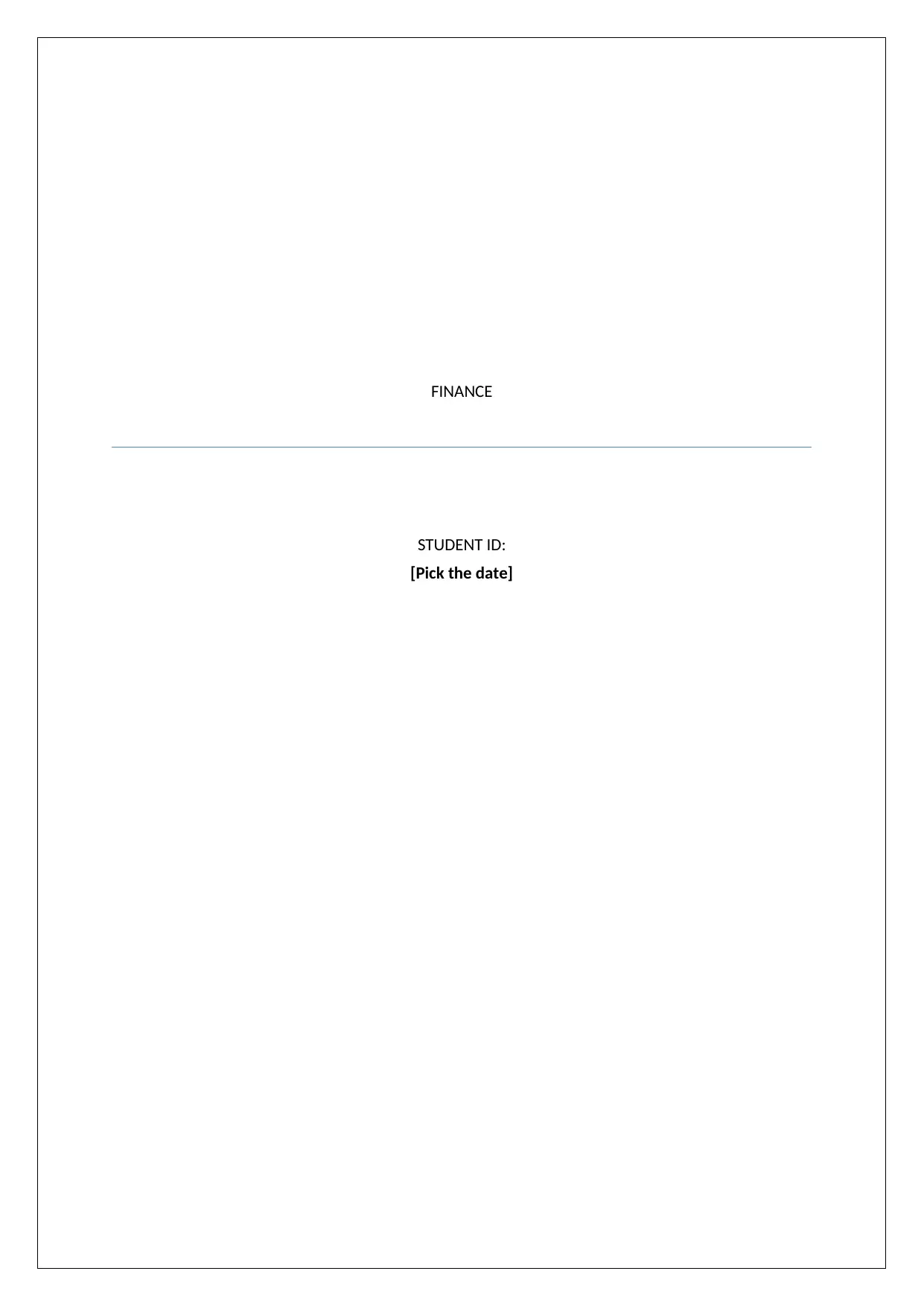
FINANCE
STUDENT ID:
[Pick the date]
STUDENT ID:
[Pick the date]
Paraphrase This Document
Need a fresh take? Get an instant paraphrase of this document with our AI Paraphraser
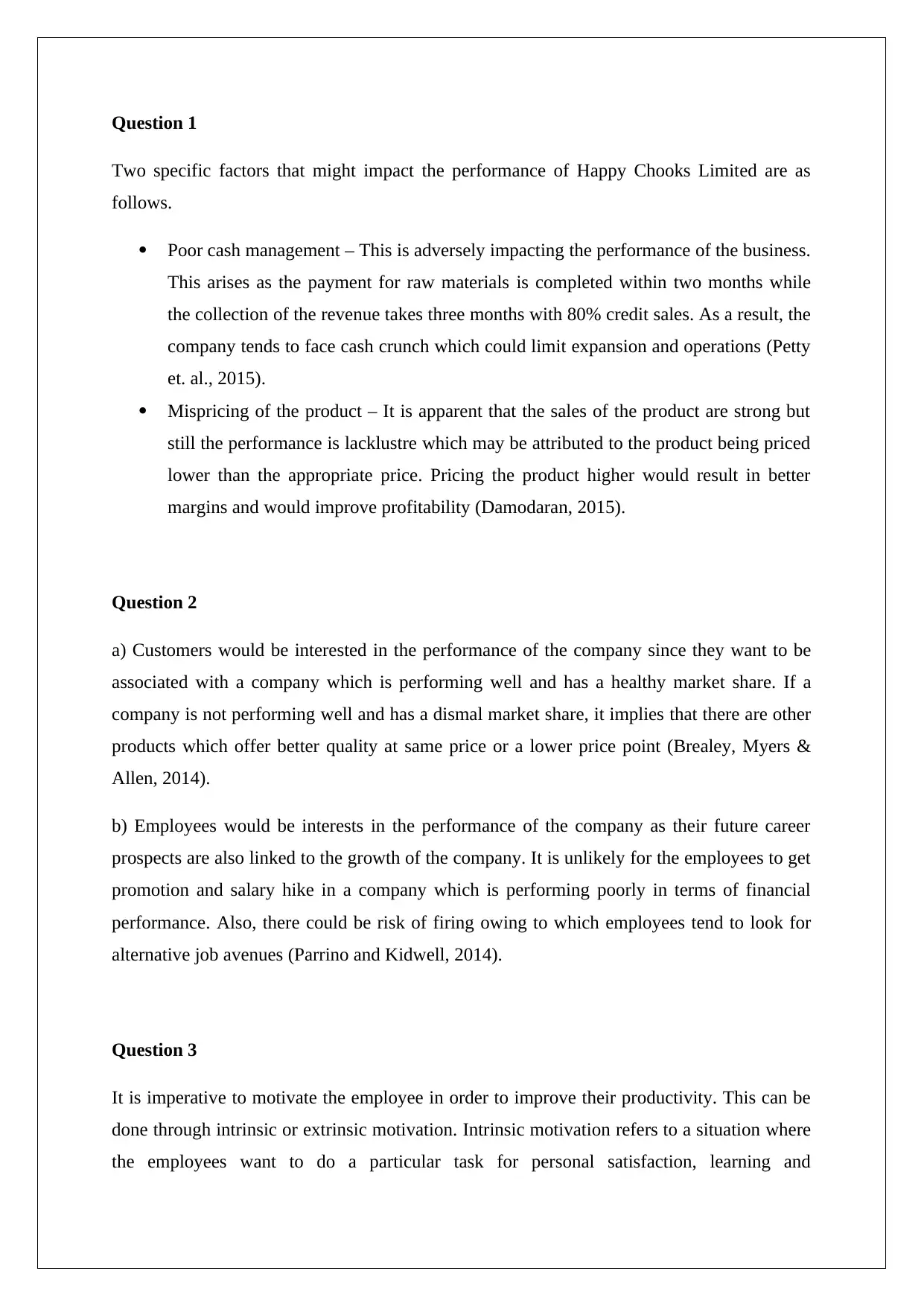
Question 1
Two specific factors that might impact the performance of Happy Chooks Limited are as
follows.
Poor cash management – This is adversely impacting the performance of the business.
This arises as the payment for raw materials is completed within two months while
the collection of the revenue takes three months with 80% credit sales. As a result, the
company tends to face cash crunch which could limit expansion and operations (Petty
et. al., 2015).
Mispricing of the product – It is apparent that the sales of the product are strong but
still the performance is lacklustre which may be attributed to the product being priced
lower than the appropriate price. Pricing the product higher would result in better
margins and would improve profitability (Damodaran, 2015).
Question 2
a) Customers would be interested in the performance of the company since they want to be
associated with a company which is performing well and has a healthy market share. If a
company is not performing well and has a dismal market share, it implies that there are other
products which offer better quality at same price or a lower price point (Brealey, Myers &
Allen, 2014).
b) Employees would be interests in the performance of the company as their future career
prospects are also linked to the growth of the company. It is unlikely for the employees to get
promotion and salary hike in a company which is performing poorly in terms of financial
performance. Also, there could be risk of firing owing to which employees tend to look for
alternative job avenues (Parrino and Kidwell, 2014).
Question 3
It is imperative to motivate the employee in order to improve their productivity. This can be
done through intrinsic or extrinsic motivation. Intrinsic motivation refers to a situation where
the employees want to do a particular task for personal satisfaction, learning and
Two specific factors that might impact the performance of Happy Chooks Limited are as
follows.
Poor cash management – This is adversely impacting the performance of the business.
This arises as the payment for raw materials is completed within two months while
the collection of the revenue takes three months with 80% credit sales. As a result, the
company tends to face cash crunch which could limit expansion and operations (Petty
et. al., 2015).
Mispricing of the product – It is apparent that the sales of the product are strong but
still the performance is lacklustre which may be attributed to the product being priced
lower than the appropriate price. Pricing the product higher would result in better
margins and would improve profitability (Damodaran, 2015).
Question 2
a) Customers would be interested in the performance of the company since they want to be
associated with a company which is performing well and has a healthy market share. If a
company is not performing well and has a dismal market share, it implies that there are other
products which offer better quality at same price or a lower price point (Brealey, Myers &
Allen, 2014).
b) Employees would be interests in the performance of the company as their future career
prospects are also linked to the growth of the company. It is unlikely for the employees to get
promotion and salary hike in a company which is performing poorly in terms of financial
performance. Also, there could be risk of firing owing to which employees tend to look for
alternative job avenues (Parrino and Kidwell, 2014).
Question 3
It is imperative to motivate the employee in order to improve their productivity. This can be
done through intrinsic or extrinsic motivation. Intrinsic motivation refers to a situation where
the employees want to do a particular task for personal satisfaction, learning and
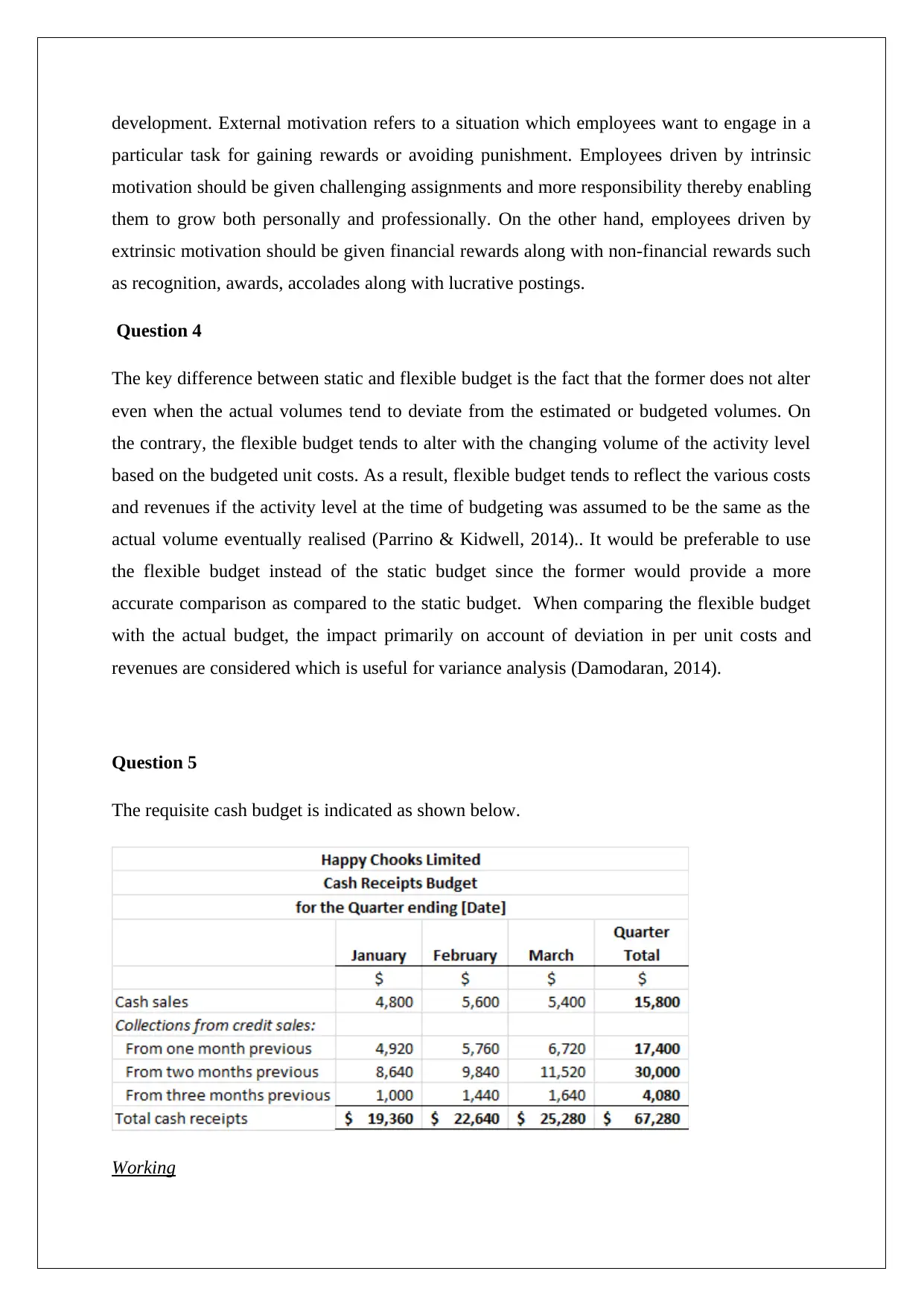
development. External motivation refers to a situation which employees want to engage in a
particular task for gaining rewards or avoiding punishment. Employees driven by intrinsic
motivation should be given challenging assignments and more responsibility thereby enabling
them to grow both personally and professionally. On the other hand, employees driven by
extrinsic motivation should be given financial rewards along with non-financial rewards such
as recognition, awards, accolades along with lucrative postings.
Question 4
The key difference between static and flexible budget is the fact that the former does not alter
even when the actual volumes tend to deviate from the estimated or budgeted volumes. On
the contrary, the flexible budget tends to alter with the changing volume of the activity level
based on the budgeted unit costs. As a result, flexible budget tends to reflect the various costs
and revenues if the activity level at the time of budgeting was assumed to be the same as the
actual volume eventually realised (Parrino & Kidwell, 2014).. It would be preferable to use
the flexible budget instead of the static budget since the former would provide a more
accurate comparison as compared to the static budget. When comparing the flexible budget
with the actual budget, the impact primarily on account of deviation in per unit costs and
revenues are considered which is useful for variance analysis (Damodaran, 2014).
Question 5
The requisite cash budget is indicated as shown below.
Working
particular task for gaining rewards or avoiding punishment. Employees driven by intrinsic
motivation should be given challenging assignments and more responsibility thereby enabling
them to grow both personally and professionally. On the other hand, employees driven by
extrinsic motivation should be given financial rewards along with non-financial rewards such
as recognition, awards, accolades along with lucrative postings.
Question 4
The key difference between static and flexible budget is the fact that the former does not alter
even when the actual volumes tend to deviate from the estimated or budgeted volumes. On
the contrary, the flexible budget tends to alter with the changing volume of the activity level
based on the budgeted unit costs. As a result, flexible budget tends to reflect the various costs
and revenues if the activity level at the time of budgeting was assumed to be the same as the
actual volume eventually realised (Parrino & Kidwell, 2014).. It would be preferable to use
the flexible budget instead of the static budget since the former would provide a more
accurate comparison as compared to the static budget. When comparing the flexible budget
with the actual budget, the impact primarily on account of deviation in per unit costs and
revenues are considered which is useful for variance analysis (Damodaran, 2014).
Question 5
The requisite cash budget is indicated as shown below.
Working
⊘ This is a preview!⊘
Do you want full access?
Subscribe today to unlock all pages.

Trusted by 1+ million students worldwide
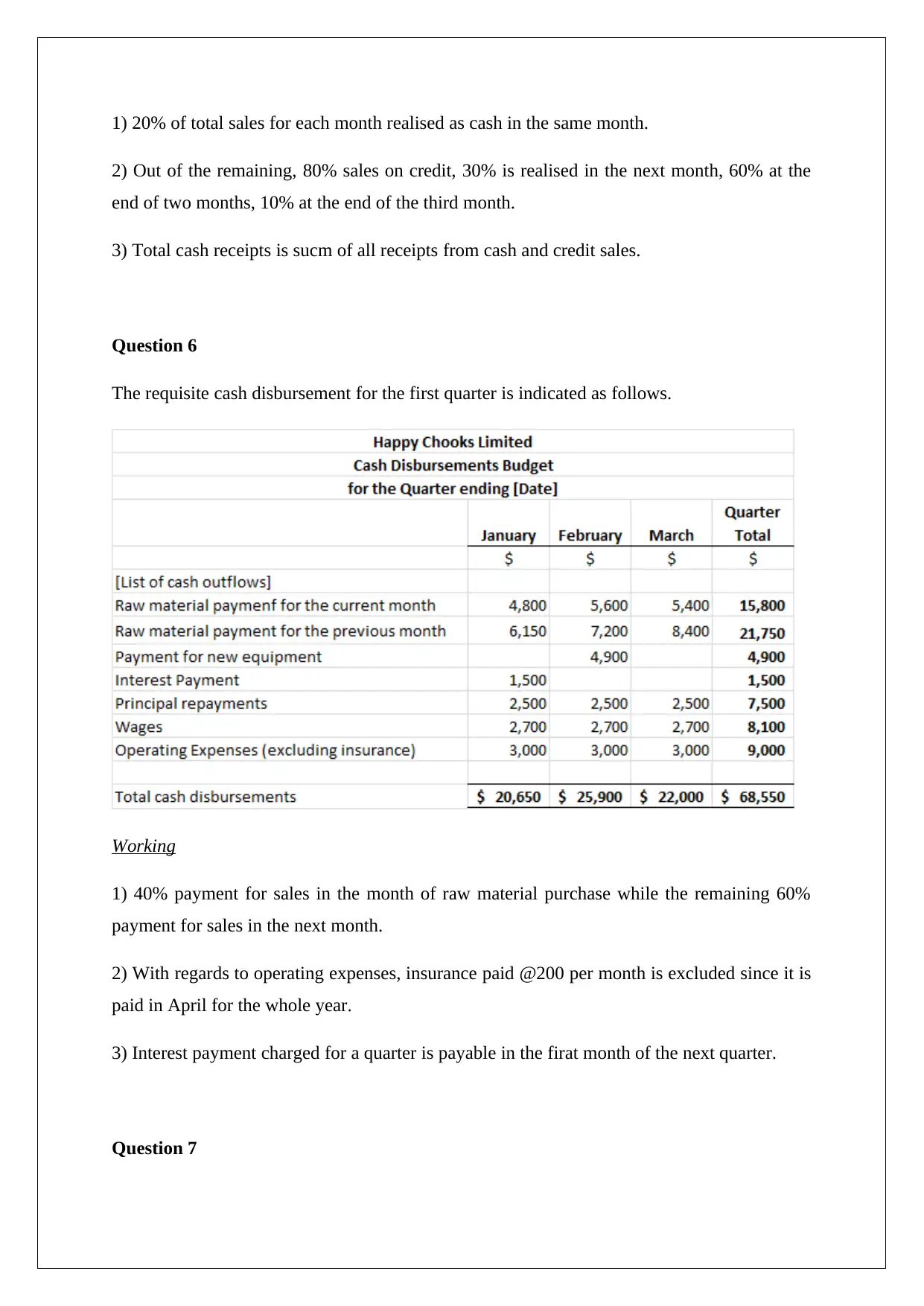
1) 20% of total sales for each month realised as cash in the same month.
2) Out of the remaining, 80% sales on credit, 30% is realised in the next month, 60% at the
end of two months, 10% at the end of the third month.
3) Total cash receipts is sucm of all receipts from cash and credit sales.
Question 6
The requisite cash disbursement for the first quarter is indicated as follows.
Working
1) 40% payment for sales in the month of raw material purchase while the remaining 60%
payment for sales in the next month.
2) With regards to operating expenses, insurance paid @200 per month is excluded since it is
paid in April for the whole year.
3) Interest payment charged for a quarter is payable in the firat month of the next quarter.
Question 7
2) Out of the remaining, 80% sales on credit, 30% is realised in the next month, 60% at the
end of two months, 10% at the end of the third month.
3) Total cash receipts is sucm of all receipts from cash and credit sales.
Question 6
The requisite cash disbursement for the first quarter is indicated as follows.
Working
1) 40% payment for sales in the month of raw material purchase while the remaining 60%
payment for sales in the next month.
2) With regards to operating expenses, insurance paid @200 per month is excluded since it is
paid in April for the whole year.
3) Interest payment charged for a quarter is payable in the firat month of the next quarter.
Question 7
Paraphrase This Document
Need a fresh take? Get an instant paraphrase of this document with our AI Paraphraser
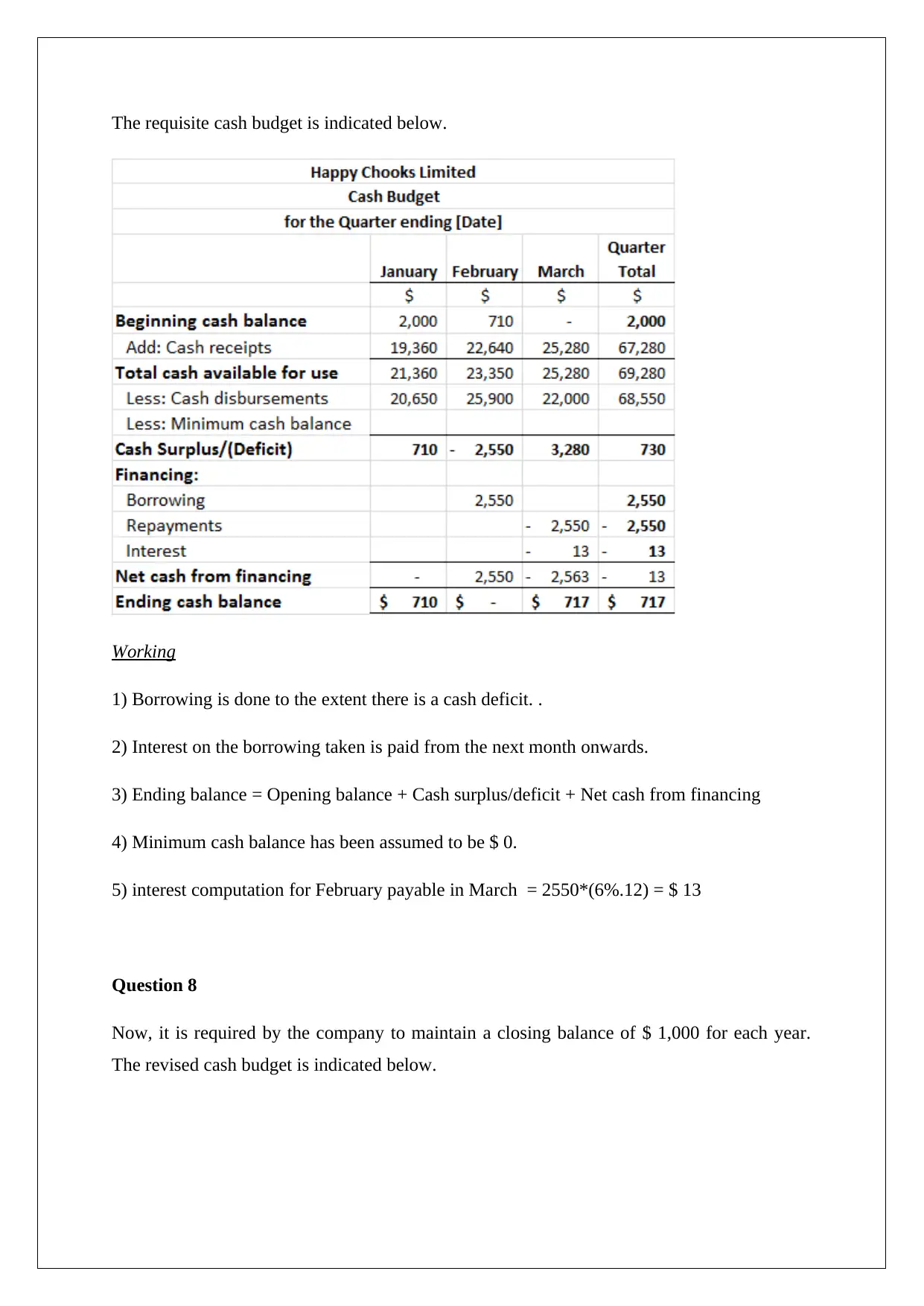
The requisite cash budget is indicated below.
Working
1) Borrowing is done to the extent there is a cash deficit. .
2) Interest on the borrowing taken is paid from the next month onwards.
3) Ending balance = Opening balance + Cash surplus/deficit + Net cash from financing
4) Minimum cash balance has been assumed to be $ 0.
5) interest computation for February payable in March = 2550*(6%.12) = $ 13
Question 8
Now, it is required by the company to maintain a closing balance of $ 1,000 for each year.
The revised cash budget is indicated below.
Working
1) Borrowing is done to the extent there is a cash deficit. .
2) Interest on the borrowing taken is paid from the next month onwards.
3) Ending balance = Opening balance + Cash surplus/deficit + Net cash from financing
4) Minimum cash balance has been assumed to be $ 0.
5) interest computation for February payable in March = 2550*(6%.12) = $ 13
Question 8
Now, it is required by the company to maintain a closing balance of $ 1,000 for each year.
The revised cash budget is indicated below.
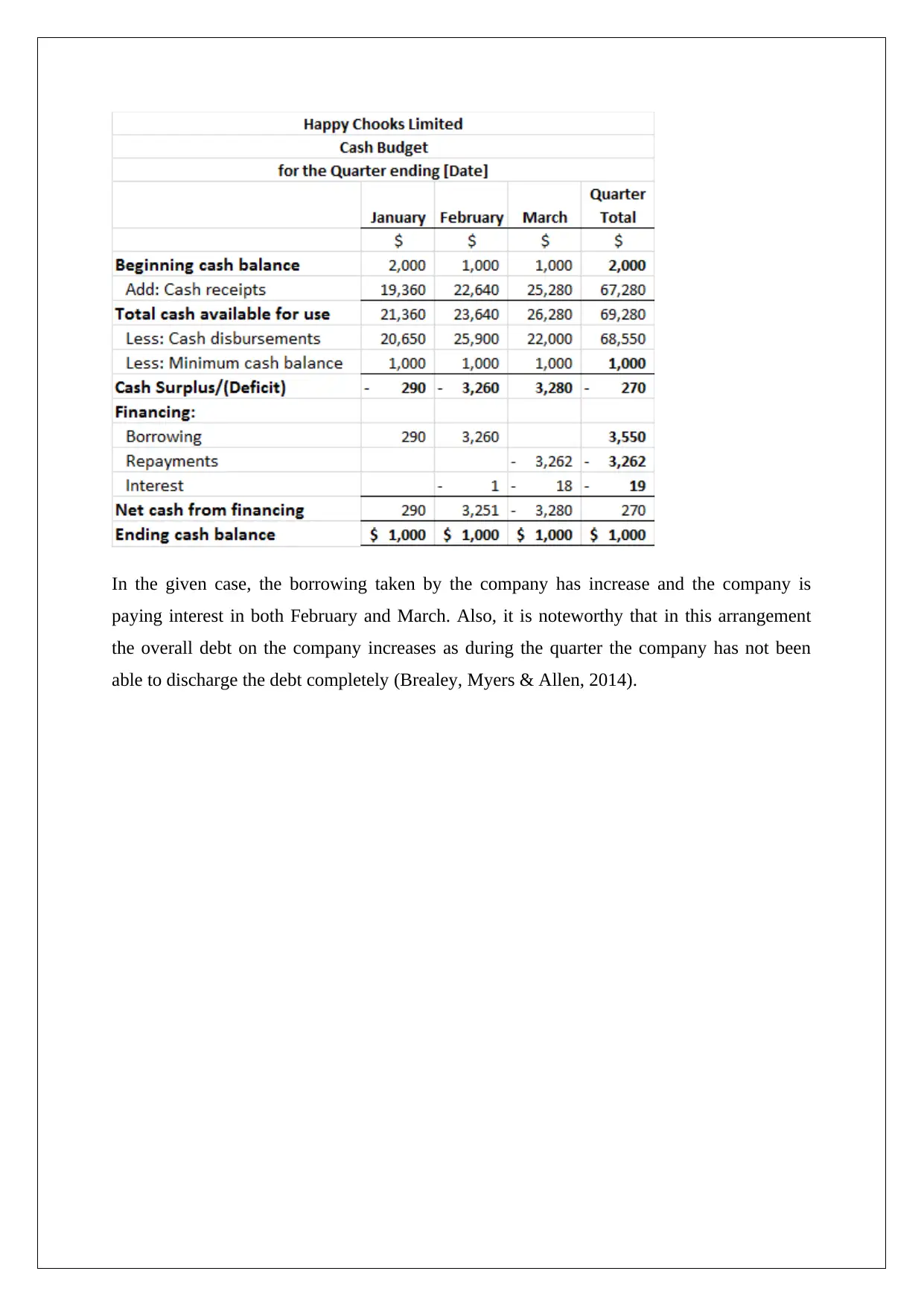
In the given case, the borrowing taken by the company has increase and the company is
paying interest in both February and March. Also, it is noteworthy that in this arrangement
the overall debt on the company increases as during the quarter the company has not been
able to discharge the debt completely (Brealey, Myers & Allen, 2014).
paying interest in both February and March. Also, it is noteworthy that in this arrangement
the overall debt on the company increases as during the quarter the company has not been
able to discharge the debt completely (Brealey, Myers & Allen, 2014).
⊘ This is a preview!⊘
Do you want full access?
Subscribe today to unlock all pages.

Trusted by 1+ million students worldwide
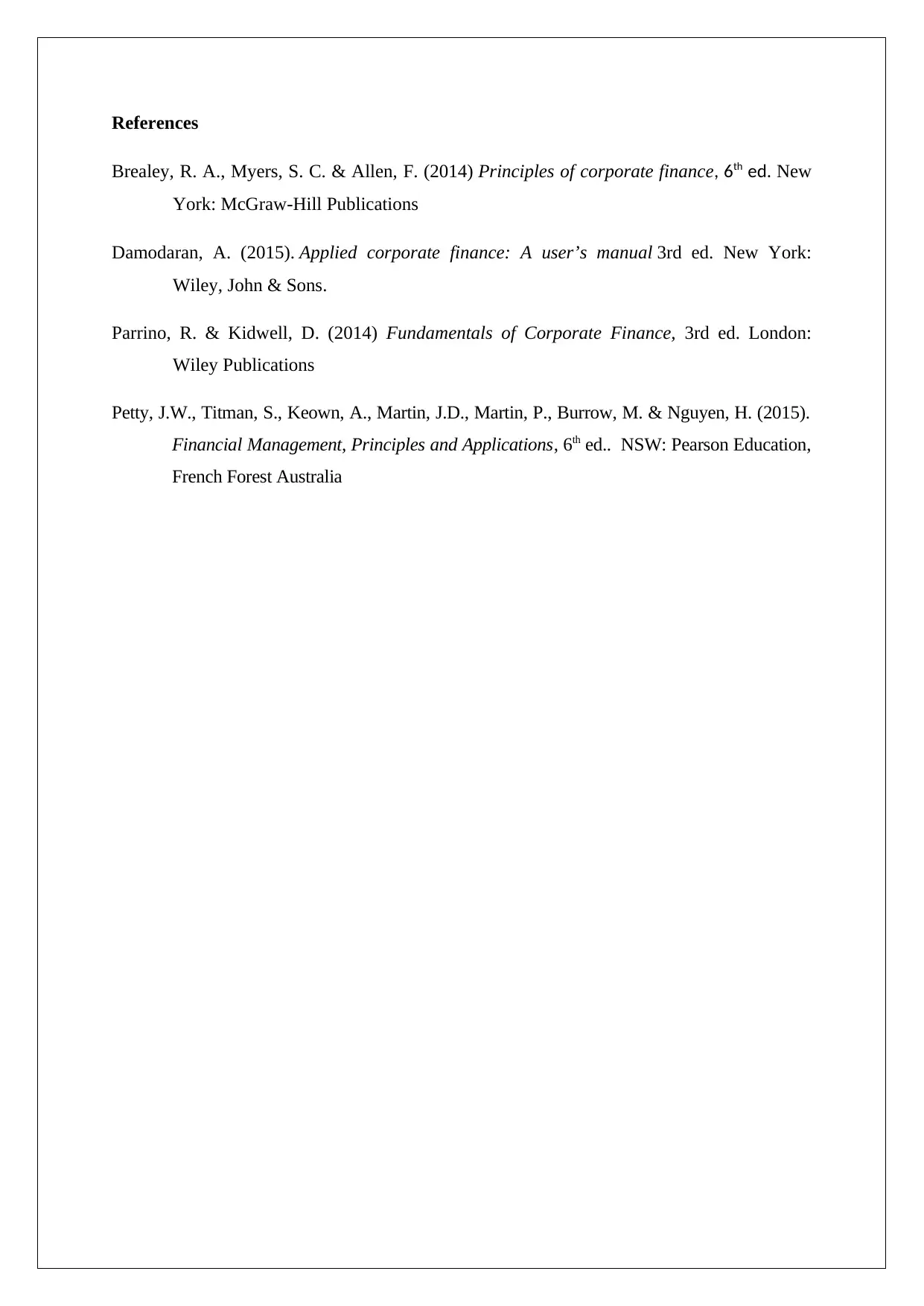
References
Brealey, R. A., Myers, S. C. & Allen, F. (2014) Principles of corporate finance, 6th ed. New
York: McGraw-Hill Publications
Damodaran, A. (2015). Applied corporate finance: A user’s manual 3rd ed. New York:
Wiley, John & Sons.
Parrino, R. & Kidwell, D. (2014) Fundamentals of Corporate Finance, 3rd ed. London:
Wiley Publications
Petty, J.W., Titman, S., Keown, A., Martin, J.D., Martin, P., Burrow, M. & Nguyen, H. (2015).
Financial Management, Principles and Applications, 6th ed.. NSW: Pearson Education,
French Forest Australia
Brealey, R. A., Myers, S. C. & Allen, F. (2014) Principles of corporate finance, 6th ed. New
York: McGraw-Hill Publications
Damodaran, A. (2015). Applied corporate finance: A user’s manual 3rd ed. New York:
Wiley, John & Sons.
Parrino, R. & Kidwell, D. (2014) Fundamentals of Corporate Finance, 3rd ed. London:
Wiley Publications
Petty, J.W., Titman, S., Keown, A., Martin, J.D., Martin, P., Burrow, M. & Nguyen, H. (2015).
Financial Management, Principles and Applications, 6th ed.. NSW: Pearson Education,
French Forest Australia
1 out of 7
Related Documents
Your All-in-One AI-Powered Toolkit for Academic Success.
+13062052269
info@desklib.com
Available 24*7 on WhatsApp / Email
![[object Object]](/_next/static/media/star-bottom.7253800d.svg)
Unlock your academic potential
Copyright © 2020–2025 A2Z Services. All Rights Reserved. Developed and managed by ZUCOL.





